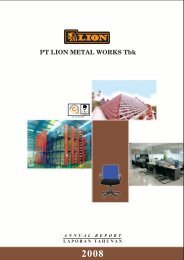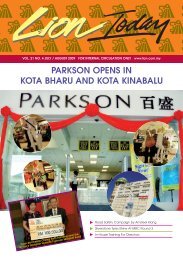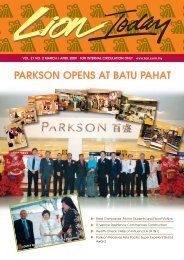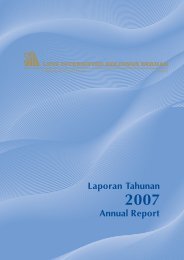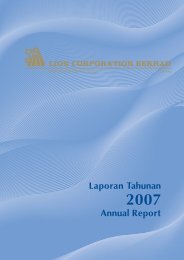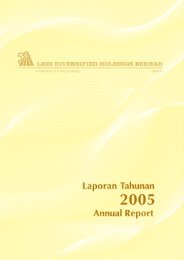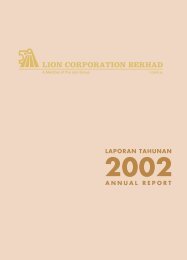continued - The Lion Group
continued - The Lion Group
continued - The Lion Group
Create successful ePaper yourself
Turn your PDF publications into a flip-book with our unique Google optimized e-Paper software.
5. CRITICAL ACCOUNTING JUDGEMENTS AND KEY SOURCES OF ESTIMATION UNCERTAINTY<br />
In the application of the <strong>Group</strong>’s accounting policies, which are described in Note 3, management is required<br />
to make judgements, estimates and assumptions about the carrying amounts of assets and liabilities that are not<br />
readily apparent from other sources. <strong>The</strong> estimates and associated assumptions are based on historical experience<br />
and other factors that are considered to be relevant. Actual results may differ from these estimates.<br />
<strong>The</strong> estimates and underlying assumptions are reviewed on an ongoing basis. Revisions to accounting estimates<br />
are recognised in the period in which the estimate is revised if the version affects only that period, or in the period<br />
of the revision and future periods if the version affects both current and future periods.<br />
Critical Accounting Estimates and Assumptions<br />
<strong>The</strong> following are the key assumptions concerning the future, and other key sources of estimation uncertainty at<br />
the balance sheet date, that have a significant risk of causing a material adjustment to the carrying amounts of<br />
assets and liabilities within the next financial year:<br />
(i) Depreciation of Property, Plant and Equipment<br />
<strong>The</strong> cost of the plant and machinery relating to manufacturing of hot rolled coils and cold rolled coils is<br />
depreciated on a straight-line basis over the assets’ useful lives. Management estimates the useful lives of<br />
these plant and machinery to be within 15 years to 30 years and residual value to be 5%. Changes in the<br />
expected level of usage and technological developments could impact the economic useful lives and the<br />
residual values of these assets, which may cause a material adjustment to future depreciation charges.<br />
(ii) Estimated Impairment of Goodwill<br />
<strong>The</strong> <strong>Group</strong> determines whether goodwill is impaired at least on an annual basis. This requires an estimation<br />
on the value-in-use of the cash-generating units (“CGU”) to which goodwill is allocated. Estimating a valuein-use<br />
amount requires management to make an estimate of the expected future cash flows of the CGU<br />
and also to choose a suitable discount rate in order to calculate the present value of those cash flows.<br />
(iii) Estimated Impairment of Tangible Assets<br />
When there is an indication that the carrying amount of an asset may be impaired, the asset’s recoverable<br />
amount, being the higher of its fair value less costs to sell and its value-in-use, will be assessed. <strong>The</strong><br />
assessment of recoverable amount involves various methodologies.<br />
Fair value of an asset is estimated by reference to net assets of the investee or based on prevailing market<br />
value determined by professional valuers.<br />
In determining the value-in-use of an asset, being the future economic benefits to be expected from its<br />
<strong>continued</strong> use and ultimate disposal, the <strong>Group</strong> makes estimates and assumptions that require significant<br />
judgements and estimates. While the <strong>Group</strong> believes these estimates and assumptions to be reasonable<br />
and appropriate, changes in these estimates and assumptions of value-in-use could impact on the <strong>Group</strong>’s<br />
financial position and results.<br />
(iv) Deferred Tax Assets<br />
Deferred tax assets are recognised for all unused tax losses and unabsorbed capital allowances to the extent<br />
that it is probable that taxable profit will be available against which the losses and capital allowances can<br />
be utilised. Significant management judgement is required to determine the amount of deferred tax assets<br />
that can be recognised, based upon the likely timing and level of future taxable profits together with future<br />
tax planning strategies. Details of deferred tax assets are disclosed in Note 22.<br />
(v) Inventories<br />
Significant judgement is required in determining the quality, grades and density of the raw materials existing<br />
at the end of the financial year. In forming judgement, the <strong>Group</strong> relies on past experience and on the work<br />
of an expert in measuring the raw materials. Details of inventories are disclosed in Note 23.<br />
61



